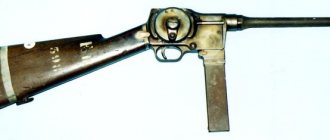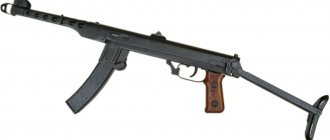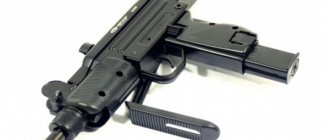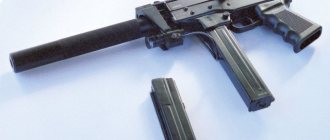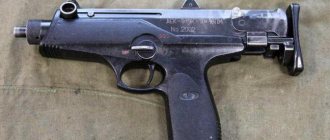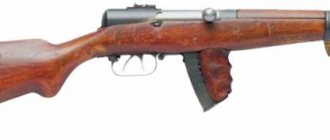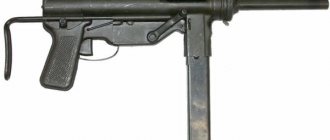9-mm submachine gun mod. 1941 Schmeisser MP-41
German submachine gun mod. 1941 belongs to rare examples of weapons from the Second World War. Developed by Hugo Schmeisser on the recommendation of representatives of infantry units at his armory in Suhl. Submachine gun mod. 1941 is a combination of two samples - a submachine gun mod. 1940, designed by Heinrich Vollmer, mass-produced (ERMA), and the Schmeisser MP-28-II submachine gun. The M R 41 is based on the M R 40 sample. The design of the trigger mechanism, as well as the wooden butt, is taken from the Schmeisser submachine gun. A weapon with a folding shoulder rest is convenient, for example, for the crews of tanks and armored vehicles, however, according to infantrymen, its accuracy in field conditions leaves much to be desired.
Without any design changes, Schmeisser used the bolt of the MP 40 submachine gun and a massive firing pin with a telescopic recoil spring housing and a buffer device, which is also an air damper for recoil and recoil of the bolt. As a result, the Schmeisser submachine gun, unlike the submachine gun mod. 1940, has a translator that allows for single and continuous fire, and instead of a metal folding shoulder rest, a wooden awkward butt with a fore-end is installed. In addition, the barrel lacks an under-barrel rail with a front stop, intended for firing from the cracks of various shelters.
For firing from the MP 41, both regular 9-mm Parabellum cartridges and special reinforced ones were used. The latter were distinguished by a varnished steel sleeve and a black bullet. The use of these cartridges for pistols was prohibited.
The MP 41 submachine guns were produced in a small series - only 26,700 units for some SS units.
The automatic operation of the submachine gun is based on the blowback recoil principle. Shooting is carried out from the rear sear. The barrel bore is locked by a massive bolt with a spent cartridge case extractor and a left-hand cocking handle. In the first samples of the MP 41, this handle in the form of a shaped blade was borrowed from the bolt of the MP 38 submachine gun. Subsequently, the handle of the MP 40 submachine gun with a safety slide was used, allowing the bolt to be fixed in the extreme forward position. The bolt has a ledge for placing on the sear in the rear position of the bolt.
The breaking of the cartridge primer is carried out “on roll-out” by the firing pin, which enters the central cavity of the bolt and is connected into a single unit with telescopic tubes, inside of which a return spring and a buffer device are located. This unit cannot be disassembled in the field.
The buffer device consists of a piston inserted into the channel of the firing pin and a buffer spring, one end of which rests against the piston and the other against the firing pin mounted on the firing pin. When struck in the rear position of the bolt and firing pin, the buffer spring is compressed, which, expanding together with the return spring, sends the bolt forward.
MP41 cartridges are fed from a replaceable 32-round box magazine with a staggered arrangement and a single-row exit. The magazine is installed from below and can serve as a stop when shooting.
The sight is rack-mounted with two sights: one constant - for shooting at a distance of up to 100 meters - and the other folding - for distances from 100 to 200 meters.
The trigger mechanism has a fire mode selector in the form of a transversely moving rod located in front of the trigger above the trigger guard. To conduct a single fire, the translator is pressed to the extreme right position, for continuous fire - to the extreme left position.
The spent cartridge is reflected through the cartridge outlet to the right, up and forward by a rigid reflector installed in the bolt box.
The submachine gun does not have a special safety device against unauthorized firing. Its role is played by a figured cutout for the charging handle in the bolt box body, into which the charging handle is inserted after cocking the bolt and running it past the sear protrusion for some time.
To attach the shoulder strap, there is a swivel on the right side of the bolt box, at its front end, the second end of the strap is attached to the cutout of the butt.
When transporting a weapon with a loaded magazine and the bolt in the forward position, there is a danger of an accidental discharge when the butt hits a hard obstacle. Many similar cases have been recorded during the operation of MP 40, PPSh and other submachine guns that fire from the rear sear. With such a blow, the bolt moves back by inertia, and if it goes behind the magazine, but reaches the sear, when it moves back, a shot occurs. The use of a slide-type fuse on the bolt handle, which fixes the bolt in the forward position, did not solve the problem, since due to forgetfulness this fuse was not turned on.
The use of a fire mode translator can be considered an unnecessary complication, since with the low rate of fire of the MP 41 it is not difficult to cut off the first shot of a burst even for a poorly trained shooter.
Main characteristics
- Caliber, mm………………………………………………………..9
- Type of cartridges……………………………………………………….9×19 mm “parabellum”
- Length of the submachine gun, mm………………………………….850
- Weight with magazine without cartridges, kg……………………………4
- Barrel length, mm……………………………………………………………..255
- Shutter stroke, mm…………………………………………………….150
- Shutter weight, kg……………………………………………………..0.38
- Weight of the striker assembled with the return spring assembly, kg...0.3
- Initial bullet speed, m/s………………………………….380
- Rate of fire, rounds/min……………………………………….350 – 400
Soldier of Fortune No. 11 2007
Model of the MP-41 "Schmeisser" assault rifle (Germany, 1940, World War 2) DE-1124
Packaged dimensions: 880 x 180 x 80 mm
Packaged weight: 3,600 g
Characteristics:
| Manufacturer: | Denix (Spain) |
| Series: | World Wars I and II 1914-1945 |
| Combat prototype: | submachine gun / submachine gun Schmeisser MP.41 (Germany) |
| Material: | metal alloy, wood |
| Dimensions: | 880x180x80 mm |
| Weight: | 3600 g - per package |
| Certificate: |
Description of MMG Denix assault rifle MP-41, DE-1124:
DE-1124 model is an exact full-size copy of the Schmeisser MP-41 submachine gun, Germany, 1940, World War 2.
Collectors will appreciate the fact that the machine gun has moving parts such as a bolt, trigger, and a removable magazine.
The model of the MP-41 "Schmeisser" assault rifle is a full-scale copy of the famous submachine gun from the Second World War. This modification was based on the previous MP-40 model; in addition, some components of the new MP version were taken from the MP 28/II modification. By the end of the Great Patriotic War, German infantry troops were only partially armed with the MP-40 submachine gun; mass production could not be established due to the complexity of the design. Back in 1941, H. Schmeisser proposed a new version - MP-41, with automatic and semi-automatic firing modes, and a wooden butt to increase the accuracy of fire.
Mass production of the MP-41, unfortunately, was never established, since it was considered inappropriate to spend the budget on the production of special weapons for the infantry, so the new product did not reach the troops. At the end of the war, Volkssturm fighters were armed with the MP-41 submachine gun. The Haenel company, owned by Schmeisser, produced about 27,500 MP-41 units, most of the weapons were sent to Croatia and Romania.
The model of the MP-41 submachine gun from the Denix brand, which specializes in the production of souvenir and decorative products, is a very high-quality copy of a combat prototype. The model has a movable trigger mechanism, the shutter clicks, and the magazine is removed. Both the weight and length of the weapon fully correspond to the original: the mass of the model is 3.235 kg, the length is 86 cm. Thanks to the use of a zinc-based alloy, the model has received sufficient strength. Like the combat prototype, the stock is made of natural wood. The weapon looks very impressive and menacing, creating the illusion of owning a real combat machine gun. Since the souvenir model does not allow shooting, this makes it possible for anyone who is interested in weapons to buy such a copy, regardless of whether they have a license or permission.
The DE-1124 model is perfect as a gift for lovers of high-quality copies of real small arms, and can become a new exhibit in any weapons collection. The layout is also suitable for educational purposes, games, entertainment and historical reconstructions.
Video review:
Information about the characteristics, configuration, appearance and color of the product is for informational purposes only.
; they are subject to change by the manufacturer without notice.
In the online store pnevmat24.ru you can buy Model MP-41 “Schmeisser” assault rifle (Germany, 1940, World War II) DE-1124 with convenient delivery throughout Russia by courier, transport company or Russian Post. We also deliver to Belarus. You can check the price and order the product on the website, by phone or write an e-mail.
MP-41 Schmeisser submachine gun
Shortly after the appearance of the MP-38 in the infantry units of the Wehrmacht and SS, infantrymen immediately began to have complaints about the new weapon
.
One of these complaints was that the folding stock of the MP-38, and later the MP-40, due to the peculiarities of its design, did not provide high shooting accuracy: it was average even by the standards of submachine guns. But on the other hand, the folding stock provided an advantage when placed inside combat vehicles for paratroopers, tank crews and motorized infantry. In 1941, Hugo Schmeisser, on his own initiative, decided to create a new model of a submachine gun, more convenient for use by ordinary infantrymen
.
The result is the MP-41 with a wooden stock, which was put into mass production at a plant owned by C.G. Haenel
, but
another arms company, Erfurter Maschinenfabrik (ERMA), filed a lawsuit against Schmeisser for unlicensed use of its components, and after the release of 26 thousand submachine guns, the production of MP-41 was finally curtailed. As in the MP-38/MP-40, the automation operates due to the free movement of the bolt during recoil
; the return spring is enclosed in a cylindrical telescopic casing designed by Volmer. Shooting can only be done from an open bolt. Fire is carried out in two modes: automatic and single; the mode switch is located above the trigger and is a button located across the stock above the trigger. To fire single shots, the translator button is moved to the right all the way, for continuous fire - accordingly, to the left all the way. As on the MP-38/MP-40, the role of the fuse is played by a slot in the receiver cover into which the bolt is retracted to secure it. The magazine is straight, double-row, box-shaped, with 32 rounds. The magazine is inserted into the neck of the magazine receiver, located at the bottom of the receiver, and is secured with a special spring-loaded latch. The sights are open, designed for a maximum firing range of 200 meters. There is no “tire” on the lower part of the barrel.
Despite the increased accuracy and operational characteristics, the MP-41 was not widely used by German troops due to its small production. Officially, they did not enter service with the Wehrmacht.
, however, they were used in German police units (including collaborationist units, and also went into service with the SS troops.
